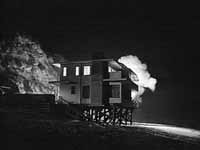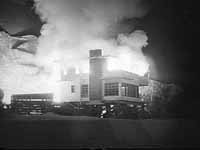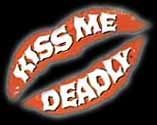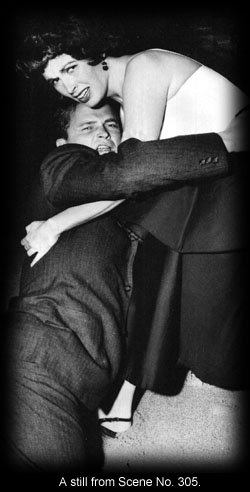I first noticed that events 2 and 4 were missing from a United Artists
16mm print when preparing the frame enlargements for my original Film
Comment article on Kiss Me Deadly in 1975. A close inspection
of that 16mm print revealed two jump cuts combining the actual house with
optical overlays and a miniature for the explosion effect. The cut is masked
by the explosion; but, in fact, the lens focal length is different and
the angle between the two shots of the house shifts several degrees. Since
the last shot is missing, the 16mm optical soundtrack is partially cut
off with it. The same cut may be noted in the video copies, although the
sound and picture in the last shot of the house are made to fade out quickly
so that the abridgement of the end title music is less apparent. A frame-by-frame
inspection of the videotape or laser disc reveals the same splice and jump
cut joining the two angles of the house. Apparently a new 35mm print shown
at an Aldrich retrospective in New York in 1995 also lacked these shots,
which would confirm that the two pieces are missing from the 35mm master
materials as they exist today.

The first camera angle on the beach house--before the splice. |

The second camera angle--after the splice.
|
As I first mentioned in the third edition of Film Noir: An Encyclopedic
Reference to the American Style (New York: Overlook/Viking, 1992),
some commentators most notably Jack Shadoian in Dreams and Dead Ends
and J.P. Telotte in Voices in the Dark, have questioned whether
Mike and Velda escape the house at all. Shadoian even suggests that since
many of Raymond Durgnat's recollections are wrong, so is his version of
the ending.2 Telotte does not know "whether such accounts
indicate the existence of an alternate ending for the film or simply represent
the kind of creative recollection--prodded by wish fulfillment--that often
marks film commentary."3 One might wonder why any commentator
would "wish" for Velda and Hammer to survive. Certainly audience
expectations might be for that survival, but in terms of narrative irony,
it would seem most apt for Hammer to witness the apocalypse which he and
others have wrought. Of whatever misrecollections Durgnat may be guilty,
this was not one. Even for those who had not seen
a 35mm print with the scenes included, as Durgnat and I had, research of the script or still
photos might have revealed the truth. I put such a still of Hammer and
Velda in the surf in the filmographic section of What Ever Happened
to Robert Aldrich? (New York: Limelight, 1994), and long before
that another shot was reproduced in Tom Hutchison's piece on Kiss Me
Deadly on page 145 of Movies of the Fifties (London: Orbis,
1982).
Even critics who accept the existence of this ending have further compounded
the problem by such assertions as "the studio added a final shot still
there in some prints showing Hammer and Velda standing amid the waves."4
Here Robin Wood suggests that Aldrich did not want these two cuts in the
finished picture. In a more recent book Edward Gallafent asserts that a
"gesture to the benign couple remains in some prints."5
These shots should "remain" in all the prints, and Aldrich never
regarded them as any sort of gesture. While they had never seen a complete
print, in their book Edward Arnold and Eugene Miller asked Aldrich about
the ending, and he replied, "I have never seen a print without, repeat,
without Hammer and Velda stumbling in the surf. That's the way it was shot,
that's the way it was released; the idea being that Mike was left alive
long enough to see what havoc he had caused, though certainly he and Velda
were both seriously contaminated."6 Aldrich's archives
including his personal 35mm print was bequeathed to Directors Guild of
America and does contain scenes 305 and 307. The viewers of the laser
disc of Kiss Me Deadly can catch a glimpse, in the theatrical trailer
included at the end of that disc, of one shot of Mike and Velda in the
surf as the house explodes.
Here's the ending of Kiss Me Deadly as an animated GIF, with stills from the deleted scenes.
(download -- 250 KB)
Alain Silver, who produces low budget movies, has written previously on Kiss Me Deadly for Film Comment and in the books Film Noir: An Encyclopedic Reference, What Ever Happened to Robert Aldrich?, and Film Noir Reader. He is currently at work on The Noir Style.
Go to: footnotes.

 So What's with the Ending of Kiss Me Deadly?
So What's with the Ending of Kiss Me Deadly? Go to an update of this article:
Go to an update of this article: 

